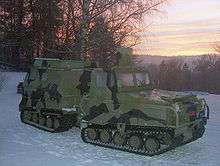Bandvagn 202

Bandvagn 202 (Bv 202) is a tracked articulated, all-terrain vehicle developed by Bolinder-Munktell, a subsidiary of Volvo, for the Swedish Army.
The vehicle is formed by two rubber Kegresse track units with a multi-directional pivot in between. The front unit contains the engine and gearbox through which power is delivered to the front and, via a propshaft in the pivot mechanism, the rear tracks. A hydraulic ram on the pivot "bends" the vehicle in the middle to steer it—there is no braking of track units for steering as on conventional tracklaying vehicles. The controls are a conventional steering wheel on the left hand front of the vehicle. It can reach a speed of 35 km/h on land and 7 km/h (4 kn) on water.
The Bv 202 carries a driver and a commander in the front unit and 8–10 troops in the trailer unit. It can be adapted for other applications.
Production started in Arvika in 1964 and ended in 1981. The Bv 202 has since been succeeded by the Hägglunds Bandvagn 206.
The Bv 202 was designed to transport troops and equipment through snow or boglands in the northern parts of Sweden. The last Swedish unit to use this vehicle was the Cavalry, who found that the manual gearbox Bv 202 was much quieter than the automatic transmission Bv 206.
The Mk1 Bv 202 is powered by a 82.5 bhp (61.5 kW) Volvo B18, the MK2 by the 97 bhp (72 kW) B20. It has less ground pressure than a skier and is fully amphibious.
The Bv 202 was used by NATO forces, and replaced the older Swedish Snow Trac ST4 Over-snow Vehicle, which was employed by the British Royal Marines under NATO.
Operators
 Canada
Canada Czechoslovakia 1
Czechoslovakia 1 Finland - replaced by Bv 206 and Sisu Nasu
Finland - replaced by Bv 206 and Sisu Nasu Netherlands
Netherlands Norway
Norway Sweden - replaced by Bv 206
Sweden - replaced by Bv 206 United Kingdom - replaced "ST4 Snow Trac Over-snow Vehicle" and subsequently replaced by Bv 206
United Kingdom - replaced "ST4 Snow Trac Over-snow Vehicle" and subsequently replaced by Bv 206
Civilian operators
 Russia At least 27 ex-Norwegian vehicles sold to Russian company for tourist use in the Murmansk area [1]
Russia At least 27 ex-Norwegian vehicles sold to Russian company for tourist use in the Murmansk area [1]
See also
Similar vehicles to the Bv 202 ATV include:
- Sisu Auto Sisu Nasu
 Finland
Finland - ST Kinetics Bronco All Terrain Tracked Carrier
 Singapore
Singapore - Hägglunds (BAE Systems AB) Bv206
 Sweden
Sweden - Hägglunds (BAE Systems AB) BvS 10
 Sweden
Sweden - (Ishimbai Transport Machine-Building Plant) Vityaz (ATV)
 Soviet Union
Soviet Union
References
External links
- Pictures
- The P5 museum
- The Munktell museum (Swedish)
- Volvo Construction Equipment historical page about BV202
- UK site on the BV202